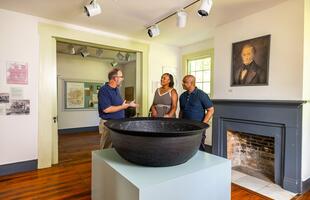6 Ways to Explore Cajun History in Louisiana
Your crash course in Cajun culture and history
Whether your Louisiana vacation is a three-day weekend, a weeklong leisure adventure or free time tacked on to a business trip, enjoy this crash course in Cajun culture and history.
What is Cajun?
Cajun is a derivative of Acadian. The Acadians were French colonists who were expelled by the British from Nova Scotia, New Brunswick and other French Canadian provinces in the 1700s. The largest concentration of fleeing Acadians found home in the flat, grassy prairies, swamps, bayous and marshlands of south Louisiana. They adapted to the topography by farming crops like rice and sugar cane, and hunted wild game, Gulf seafood, as well as alligators and crawfish.
Cajun Culture in Louisiana
Looking for how to experience Cajun culture in Louisiana today? Three centuries later, the Cajuns still call the area we refer to as Acadiana home. Cajun culture remains surprisingly intact, readily identifiable and easy for a traveler to find. Many residents still speak fluent French as a second language. The region’s two indigenous music genres — Cajun and zydeco — can be heard nightly at venues in larger cities such as Lafayette, Lake Charles and Houma as well as in small outlying and in-between towns. Indigenous Cajun cuisine can be tasted any time of day in and between those locales.
How to Experience Cajun Culture, History, Food & Music in Louisiana
1. Explore the Jean Lafitte National Historical Park and Preserve
Part of the Jean Lafitte National Historical Park and Preserve, the Wetlands Acadian Cultural Center in Thibodaux focuses on the geographic sub-regions reflected in its name. The park’s five other sites are spread throughout south Louisiana and include outdoor nature preserves like the Barataria Preserve in Marrero and other cultural centers like the Prairie Acadian Cultural Center in Eunice.
2. Wander through the Bayou Terrebonne Waterlife Museum in Houma
The Bayou Terrebonne Waterlife Museum features exhibits that celebrate the industries and traditions of the Cajun culture. The museum has a charming back porch overlooking the bayou, and guests can enjoy local Cajun musicians on Tuesdays, plus events throughout the month. Stop by the gift shop for Louisiana-themed art, jewelry and other merchandise.
3. Visit LARC’s Acadian Village and Vermilionville in Lafayette
Both LARC’s Acadian Village and Vermilionville are reproduced Cajun colonial villages that allow visitors to experience the daily lives of early Cajun settlers. The Acadian Village includes several settlers’ homes, including one built circa 1800, a blacksmith’s shop and a doctor’s museum. Vermilionville is a living history museum, with interpreters walking the park to share stories of former residents. At Vermilionville, stay for lunch at La Cuisine de Maman for daily plate lunch specials, like seafood gumbo or fried Louisiana catfish.
4. Peruse the Acadian Museum in Erath
The Acadian Museum in Erath celebrates Cajun history with exhibits about Acadia, a colony of New France in northeastern North America, in the early 1600s. The collection includes a copy of the Queen’s Royal Proclamation (2003), a formal apology from Queen Elizabeth II for the deportation of the Acadians and a cloth map showing the land grant given to the first Acadian settler around 1780.
5. Take in the Acadian Memorial in St. Martinville
The Acadian Memorial honors the Acadian men, women and children who sought refuge in Louisiana after their removal from Canada. The 30-foot-by-12-foot mural depicts the arrival of the Cajuns in Louisiana. Artist Robert Dafford is said to have used descendants of the region’s first Cajun families as models when he created the mural. The eternal flame, located in the memorial’s garden, symbolizes the Acadians’ dedication to their culture despite great hardship, and the Acadian Odyssey quilt was hand-stitched by dozens of members of the Quilters’ Guild Acadienne, depicting their journey from Canada to south Louisiana.
6. Check out Louisiana State Museums
Part of the Louisiana State Museums, The Presbytère includes exhibitions like Mardi Gras: It’s Carnival Time in Louisiana, a peek at the riotous rituals of Mardi Gras throughout the state. Another great stop for Cajun history and culture outside of the region is Capitol Park Museum in downtown Baton Rouge.





